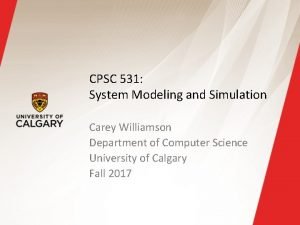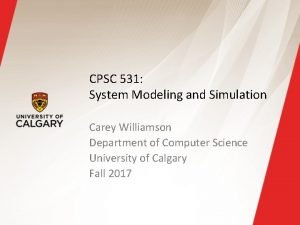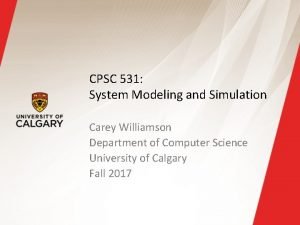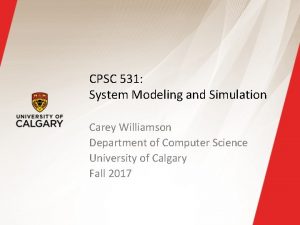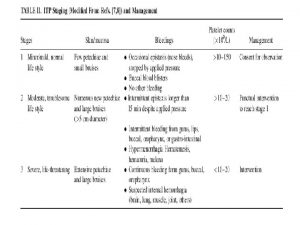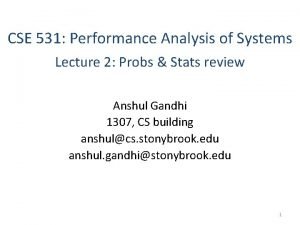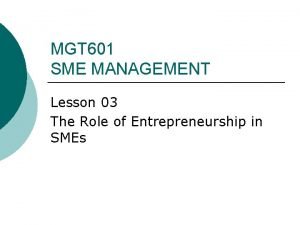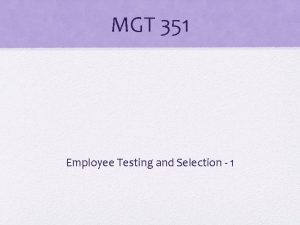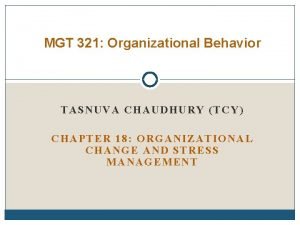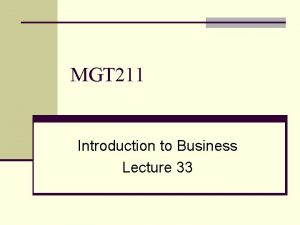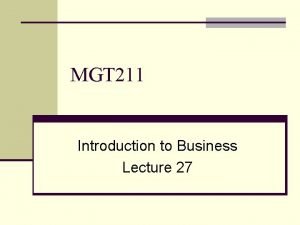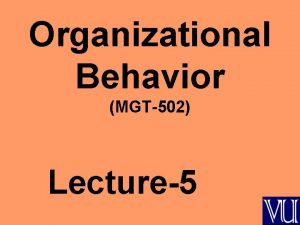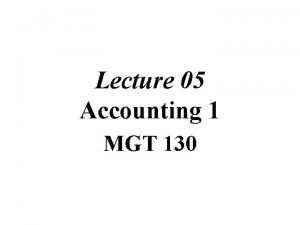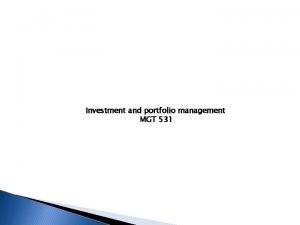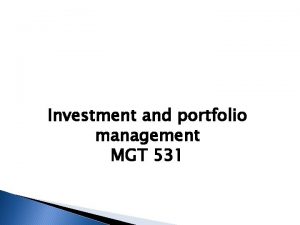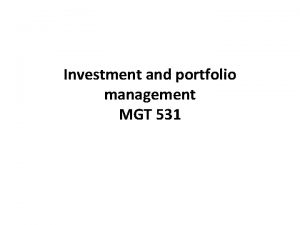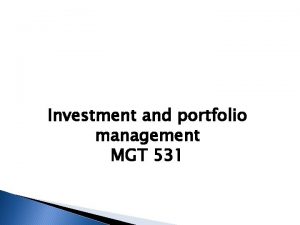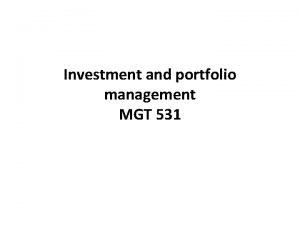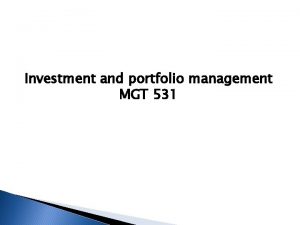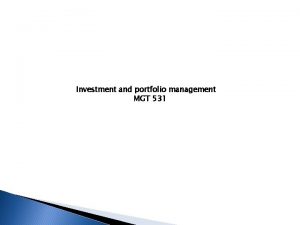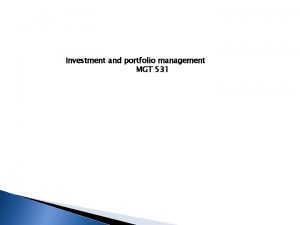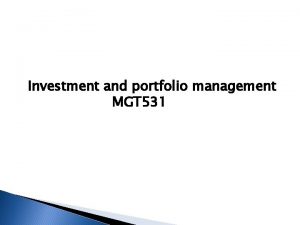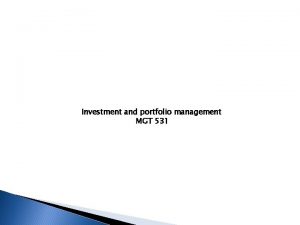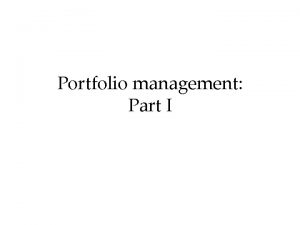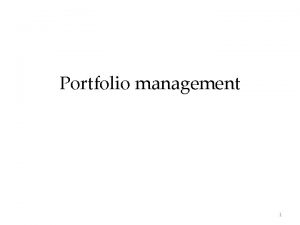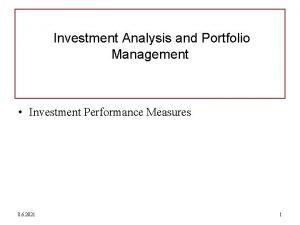Investment and portfolio management MGT 531 Lecture 10




























- Slides: 28

Investment and portfolio management MGT 531 � Lecture #10

References � The course assumes little prior applied knowledge in the area of finance. � References � Kristina (2010) ‘Investment Analysis and Portfolio Management’.

Summary of last lecture � Perfect positive correlation � Perfect negative correlation � Zero correlation � degree of relationship � coefficient of determination � market portfolio

Contents of today's lecture � SUMMARY OF THE DIFERENT CONCEPTS IN QUANTITATIVE METHODS IN PORTFOLIO MANAGEMENT � QUESTIONS AND PROBLEMS

Summary � � � 1. The main characteristics of any investment are investment return and risk. However to compare various alternatives of investments, the precise quantitative measures for both of these characteristics are needed. 2. General definition of return is the benefit associated with an investment. Many investments have two components of their measurable return: (1) a capital gain or loss; (2) some form of income. The holding period return is the percentage increase in returns associated with the holding period.

Summary � � � 3. Investor can‘t compare the alternative investments using holding period returns, if their holding periods (investment periods) are different. In these cases arithmetic average return or sample mean of the returns can be used. 4. Both holding period returns and sample mean of returns are calculated using historical data. However all the investors’ decisions are focused to the future, or to expected results from the investments. The expected rate of return of investment is the statistical measure of return: which is the sum of all possible rates of returns for the same investment weighted by probabilities.

Summary � 5. Risk can be defined as a chance that the actual outcome from an investment will differ from the expected outcome. The total risk of investments can be measured with such common absolute measures used in statistics as variance and standard deviation. � Variance can be calculated as a potential deviation of each possible investment rate of return from the expected rate of return. � Standard deviation is calculated as the square root of the variance. The more variable the possible outcomes that can occur, the greater the risk. �

summary � 6. Covariance and correlation coefficient are used to answer the question, that what is the relationship between the returns on different assets? . � Covariance and correlation coefficient are related and they generally measure the same phenomenon – the relationship between two variables. � § 8. The sample covariance is estimated: when the investor hasn‘t enough information about the underlying probability distributions for the returns of two assets and § then the sample of historical returns is used. �

summary � The population covariance is estimated: § when the investor has enough information about the underlying probability distributions for the returns of two assets and § can identify the actual probabilities of various pairs of the returns for two assets at the same time.

summary 9. Analyzing relationship between the assets in the same portfolio using covariance � � � For portfolio formation it is important to identify which of the three possible outcomes exists: positive covariance, negative covariance or zero covariance

Summary. � If the positive covariance between two assets is identified , the common recommendation for the investor would be not to put both of these assets to the same portfolio, � because their returns move in the same direction and the risk in portfolio will be not diversified; � if the negative - the common recommendation for the investor would be to include both of these assets to the portfolio, because their returns move in the contrariwise directions and the risk in portfolio could be diversified; if the zero covariance - it means that there is no relationship between the rates of return of two assets. � �

Summary � � � 10. The correlation coefficient between two assets is closely related to their covariance. the correlation coefficient can range only from -1, 0 to +1, 0. The more close the absolute meaning of the correlation coefficient to 1, 0, the stronger the relationship between the returns of two assets. Using correlation coefficients instead of covariance, investor can immediately asses the degree of relationship between assets returns. 11. The coefficient of determination is calculated as the square of correlation coefficient and shows how much variability in the returns of one asset can be associated with variability in the returns of the other.

Summary 12. Theoretical interpretation of the market portfolio is that it involves every single risky asset in the global economic system, and � contains each asset in proportion to the total market value of that asset relative to the total value of all other assets (value weighted portfolio). � Investors can think of the market portfolio as the ultimate market index. � 13. Stock’s characteristic line describes the relationship between the stock and the market, � shows the return, investor expect the stock to produce, given that a particular rate of return appears for the market and � � helps to assess the risk characteristics of one stock relative to the market.

summary � 14. The slope of the characteristic line is called the Beta factor. � The Beta factor of the stock is an indicator of the degree to which the stock reacts to the changes in the returns of the market portfolio. 15. The intercept is the point where characteristic line passes through the vertical axis. � The interpretation of the intercept from the investor’s point of view is that: � it shows, what would be the rate of return of the stock? , if the rate of return in the market is zero.

Summary � 16. The residual variance describes the deviation of the asset returns from its characteristic line. � Key-terms • Beta factor, characteristic line, • Coefficient of correlation, • Coefficient of determination • Correlation, • Covariance, Expected rate of return, • Holding period return, Intercept Investment risk, • Market portfolio, • Population covariance, • Probability, • Residual variance, • Return on investment, • Sample mean of return, • Sample standard deviation, • Sample covariance, • Sample variance, • Simple probability distribution • Standard deviation, • Variance � � �

Questions and problems � � � � � 1. Comment why methods and tools of the statistics are so important in investment decision making. 2. Distinguish between historical returns and expected returns. 3. Define the components of holding period return. Can any of these components be negative? 4. When should the sample mean of return be used instead of expected rate of return? 5. What does a probability distribution describe? 6. What does covariance measure? If two assets are said to have positive covariance, what does it mean? 7. Explain, why doesn’t an estimated absolute covariance number tell the investor much about the relationship between the returns on the two assets? 8. How do you understand an investment risk and what statistic tools can be used to measure it?

Questions and problems � 9. Describe the Beta factor. � 10. What does the characteristic line tells to investor? Why stock characteristic lines are different for the securities traded in the same market? � 11. With which of stock’s characteristic line definitions presented below you disagree? � a) Stock’s characteristic line describes the relationship between the stock � and the market; � b) Stock’s characteristic line shows the return investor expect the stock to produce, given that a particular rate of return appears for the market;

Questions and problems � � � � c) Stock’s characteristic line describes the relationship between rate of return of any two different stocks in the market; d) I agree with all definitions presented above. 12. Calculate the main statistic measures to explain the relationship between stock A and the market portfolio: • The sample covariance between rate of return for the stock A and the market; • The sample Beta factor of stock A; • The sample correlation coefficient between the rates of return of the stock A and the market; • The sample coefficient of determination associated with the stock A and the market.

3. Theory for investment portfolio formation � Mini-contents � 1. Portfolio theory. � 2. Markowitz portfolio theory. � 3. The Risk and Expected Return of a Portfolio. � 3. 1. Capital Asset Pricing Model (CAPM). � 3. 2. Arbitrage Pricing Theory (APT). � 3. 3. Market efficiency theory. � Summary � Key terms � Questions and problems

Portfolio theory � � � � Markowitz portfolio theory The author of the modern portfolio theory is Harry Markowitz who introduced the analysis of the portfolios of investments in his article “Portfolio Selection” published in the Journal of Finance in 1952. The new approach presented in this article included portfolio formation by considering: the expected rate of return and risk of individual stocks and, crucially, their interrelationship as measured by correlation.

Portfolio theory � � Prior to this, investors : examined investments individually, build up portfolios of attractive stocks, and did not consider how they related to each other. � Markowitz showed how it might be possible to better of these simplistic portfolios by taking into account the correlation between the returns on these stocks. � The diversification plays a very important role in the modern portfolio theory. �

Portfolio theory 2. Markowitz approach is viewed as a single period approach: at the beginning of the period the investor must make a decision in what particular securities to invest and hold these securities until the end of the period. � Because a portfolio is a collection of securities, � this decision is equivalent to selecting an optimal portfolio from a set of possible portfolios. � 1. � � Essentiality of the Markowitz portfolio theory is the problem of optimal portfolio selection.

Portfolio theory � � � § § Indifference curves The method that should be used in selecting the most desirable portfolio involves the use of indifference curves. Indifference curves represent an investor’s preferences for risk and return. These curves should be drawn, putting the investment return on the vertical axis and the risk on the horizontal axis. Following Markowitz approach: the measure for investment return is expected rate of return and a measure of risk is standard deviation.

Indifference curves (figures) � � Each indifference curve represents the most desirable investment or investment portfolio for an individual investor. That means, that any of investments (or portfolios) plotted on the indifference curves are equally desirable to the investor.

Features of indifference curves: � � � All portfolios that lie on a given indifference curve are equally desirable to the investor. Indifference curves cannot intersect. An investor has an infinitive number of indifference curves. Every investor can represent several indifference curves (for different investment tools). Every investor has a map of the indifference curves representing his or her preferences for expected returns and risk (standard deviations) for each potential portfolio.

Portfolio theory Two important fundamental assumptions examining indifference curves and applying them to Markowitz portfolio theory: � Assumption of non-satiation 1. The investors are assumed to prefer higher levels of return to lower levels of return: , � because the higher levels of return allow the investor to spend more on consumption at the end of the investment period. � Thus, given two portfolios with the same standard deviation, the investor will choose the portfolio with the higher expected return. � This is called an assumption of non-satiation. � Assumption of risk aversion 2. Investors are risk averse. It means that the investor when given the choice, will choose the investment or investment portfolio with the smaller risk. � This is called assumption of risk aversion. �

Portfolio theory � � � An example how the investor chooses between 3 investments – A, B and C. Following the assumption of non-satiation, investor will choose A or B which have the higher level of expected return than C. Following the assumption of risk aversion investor will choose A, despite of the same level of expected returns for investment A and B, because the risk (standard deviation) for investment A is lower than for investment B. In reality there an infinitive number of portfolios available for the investment. Is it means that the investor needs to evaluate all these portfolios on return and risk basis?

Markowitz portfolio theory answers this question using efficient set theorem: � an investor will choose his/ her optimal portfolio from the set of the portfolios that � (1) offer maximum expected return for varying level of risk, and � (2) offer minimum risk for varying levels of expected return. � Efficient set of portfolios involves the portfolios that the investor will find � optimal ones. These portfolios are called an efficient frontier. � The efficient frontier can be described by the curve in the risk-return space with the highest expected rates of return for each level of risk. �
 Investment analysis and portfolio management
Investment analysis and portfolio management Scope of investment analysis and portfolio management
Scope of investment analysis and portfolio management Investment analysis and portfolio management course
Investment analysis and portfolio management course Investment analysis & portfolio management
Investment analysis & portfolio management Fixed investment and inventory investment
Fixed investment and inventory investment 531 area code
531 area code Onap network slicing
Onap network slicing Cpsc 531
Cpsc 531 Cpsc 531
Cpsc 531 Cpsc 531
Cpsc 531 Cpsc 531
Cpsc 531 531 warm up
531 warm up Itp 100
Itp 100 Cse 531
Cse 531 01:640:244 lecture notes - lecture 15: plat, idah, farad
01:640:244 lecture notes - lecture 15: plat, idah, farad Student portfolio examples pdf
Student portfolio examples pdf Mgt 323
Mgt 323 Financial accounting scope
Financial accounting scope Mgt 601
Mgt 601 Mgt 351 nsu course outline
Mgt 351 nsu course outline Assignment mgt340
Assignment mgt340 Mgt321
Mgt321 Luyana211
Luyana211 A product can be
A product can be Mgt 411
Mgt 411 Mgt 385
Mgt 385 Mgt 613
Mgt 613 Mgt502
Mgt502 Mgt 130
Mgt 130







